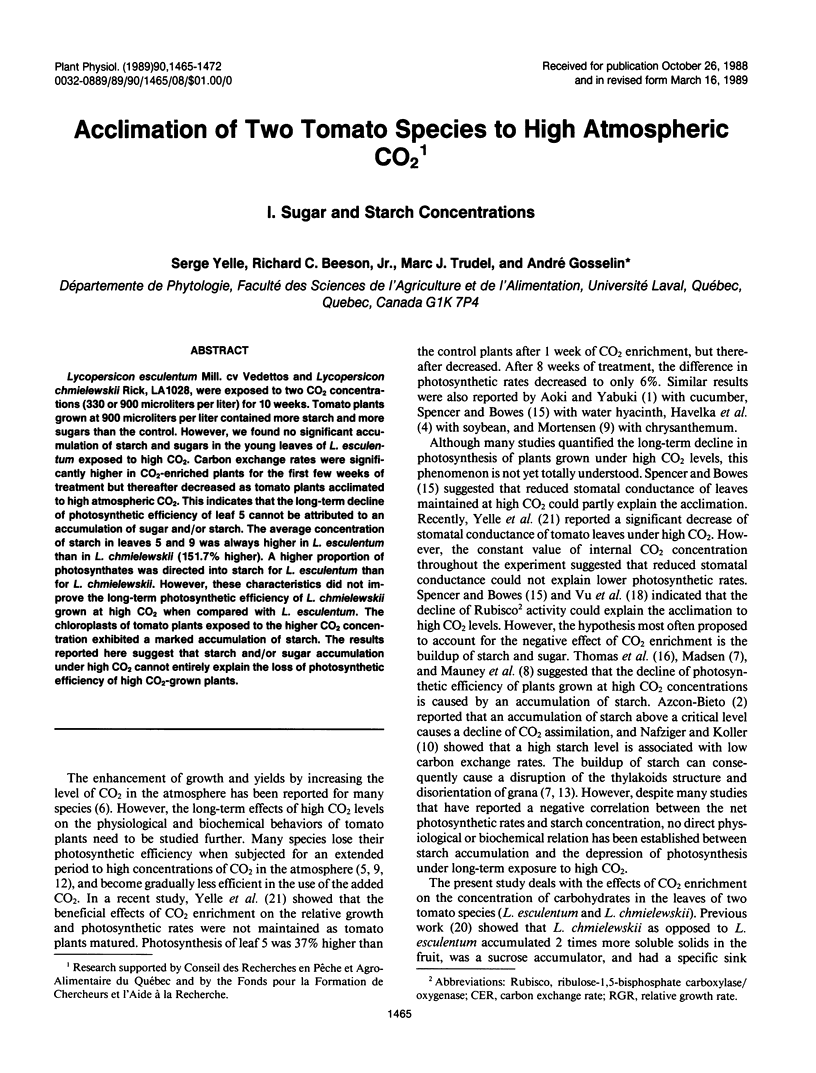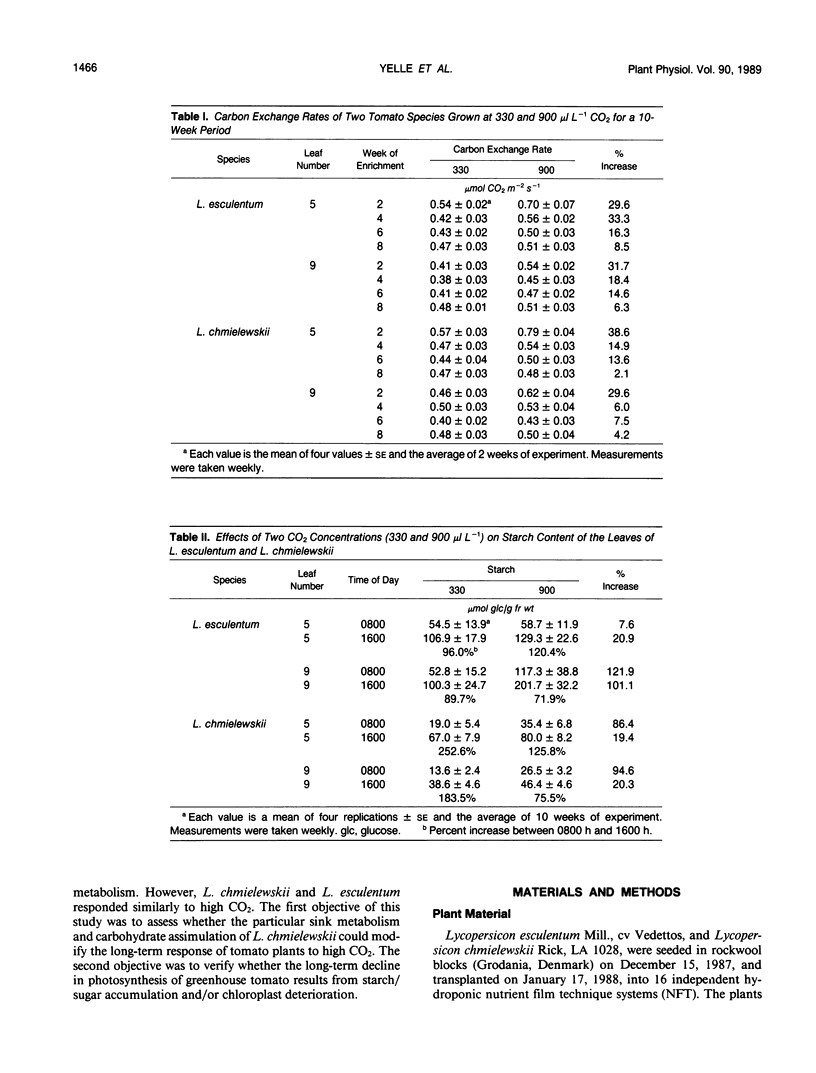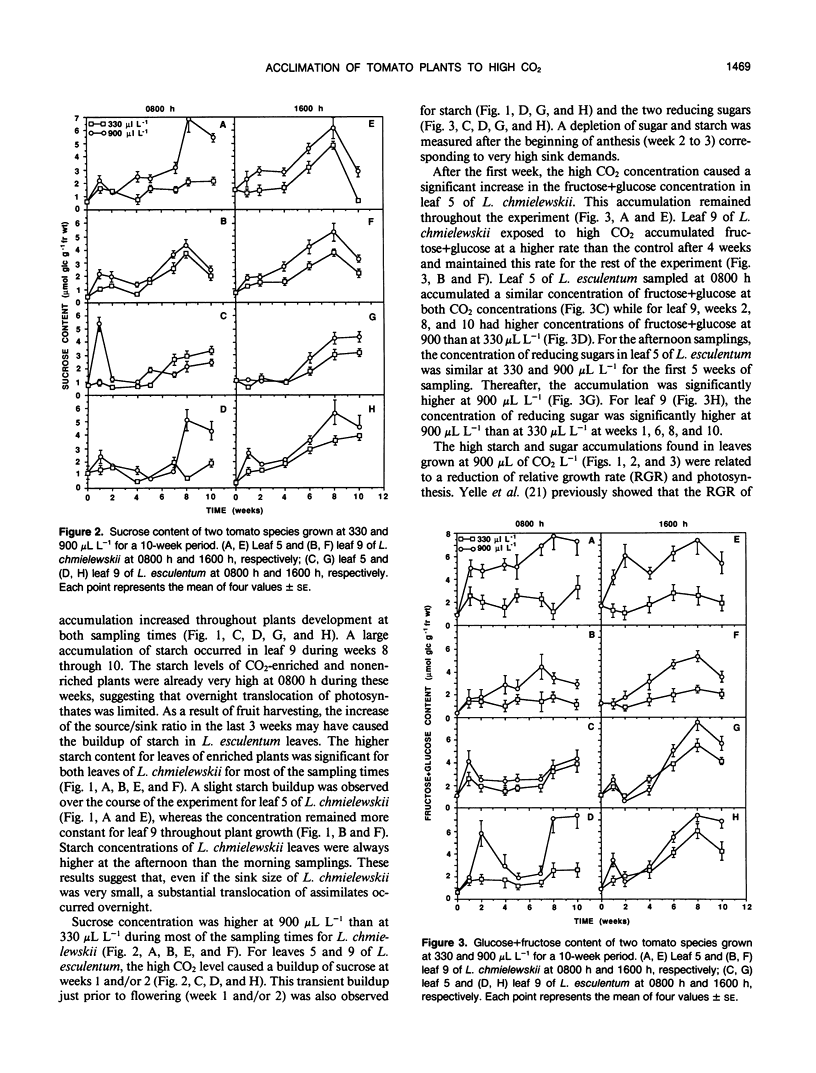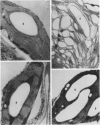Abstract
Lycopersicon esculentum Mill. cv Vedettos and Lycopersicon chmielewskii Rick, LA 1028, were exposed to two CO2 concentrations (330 or 900 microliters per liter) for 10 weeks. Tomato plants grown at 900 microliters per liter contained more starch and more sugars than the control. However, we found no significant accumulation of starch and sugars in the young leaves of L. esculentum exposed to high CO2. Carbon exchange rates were significantly higher in CO2-enriched plants for the first few weeks of treatment but thereafter decreased as tomato plants acclimated to high atmospheric CO2. This indicates that the long-term decline of photosynthetic efficiency of leaf 5 cannot be attributed to an accumulation of sugar and/or starch. The average concentration of starch in leaves 5 and 9 was always higher in L. esculentum than in L. chmielewskii (151.7% higher). A higher proportion of photosynthates was directed into starch for L. esculentum than for L. chmielewskii. However, these characteristics did not improve the long-term photosynthetic efficiency of L. chmielewskii grown at high CO2 when compared with L. esculentum. The chloroplasts of tomato plants exposed to the higher CO2 concentration exhibited a marked accumulation of starch. The results reported here suggest that starch and/or sugar accumulation under high CO2 cannot entirely explain the loss of photosynthetic efficiency of high CO2-grown plants.
Full text
PDF







Images in this article
Selected References
These references are in PubMed. This may not be the complete list of references from this article.
- Azcón-Bieto J. Inhibition of photosynthesis by carbohydrates in wheat leaves. Plant Physiol. 1983 Nov;73(3):681–686. doi: 10.1104/pp.73.3.681. [DOI] [PMC free article] [PubMed] [Google Scholar]
- Nafziger E. D., Koller H. R. Influence of Leaf Starch Concentration on CO(2) Assimilation in Soybean. Plant Physiol. 1976 Apr;57(4):560–563. doi: 10.1104/pp.57.4.560. [DOI] [PMC free article] [PubMed] [Google Scholar]
- Ozbun J. L., Hawker J. S., Greenberg E., Lammel C., Preiss J. Starch Synthetase, Phosphorylase, ADPglucose Pyrophosphorylase, and UDPglucose Pyrophosphorylase in Developing Maize Kernels. Plant Physiol. 1973 Jan;51(1):1–5. doi: 10.1104/pp.51.1.1. [DOI] [PMC free article] [PubMed] [Google Scholar]
- Peet M. M., Huber S. C., Patterson D. T. Acclimation to High CO(2) in Monoecious Cucumbers : II. Carbon Exchange Rates, Enzyme Activities, and Starch and Nutrient Concentrations. Plant Physiol. 1986 Jan;80(1):63–67. doi: 10.1104/pp.80.1.63. [DOI] [PMC free article] [PubMed] [Google Scholar]
- Sasek T. W., Delucia E. H., Strain B. R. Reversibility of Photosynthetic Inhibition in Cotton after Long-Term Exposure to Elevated CO(2) Concentrations. Plant Physiol. 1985 Jul;78(3):619–622. doi: 10.1104/pp.78.3.619. [DOI] [PMC free article] [PubMed] [Google Scholar]
- Spencer W., Bowes G. Photosynthesis and Growth of Water Hyacinth under CO(2) Enrichment. Plant Physiol. 1986 Oct;82(2):528–533. doi: 10.1104/pp.82.2.528. [DOI] [PMC free article] [PubMed] [Google Scholar]
- Vu C. V., Allen L. H., Bowes G. Effects of Light and Elevated Atmospheric CO(2) on the Ribulose Bisphosphate Carboxylase Activity and Ribulose Bisphosphate Level of Soybean Leaves. Plant Physiol. 1983 Nov;73(3):729–734. doi: 10.1104/pp.73.3.729. [DOI] [PMC free article] [PubMed] [Google Scholar]
- Yelle S., Hewitt J. D., Robinson N. L., Damon S., Bennett A. B. Sink Metabolism in Tomato Fruit : III. Analysis of Carbohydrate Assimilation in a Wild Species. Plant Physiol. 1988 Jul;87(3):737–740. doi: 10.1104/pp.87.3.737. [DOI] [PMC free article] [PubMed] [Google Scholar]




